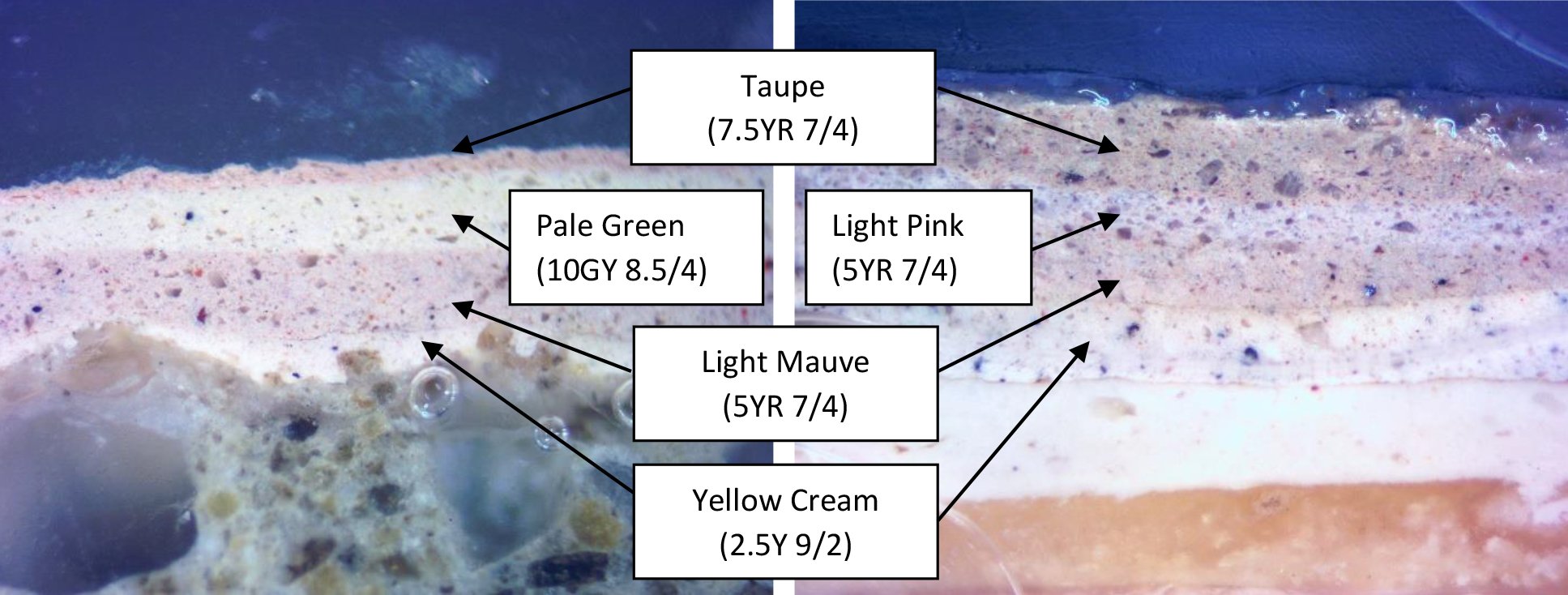Federal American National Bank
Washington, DC
Before Restoration
Fully Restored
Before Restoration
Before Restoration
Microscopy with ultraviolet light paint analysis was performed as part of an extensive materials investigation to establish the original color palette. This sample, shown at 100x magnification, was taken from a faux window opening and shows the multiple layers of paint applied over the years.
Professional photography by Alan Karchmer
The historic Federal American National Bank building, designed in the Classical Revival style, is located in downtown Washington, DC. Completed in 1926, the building exterior and interiors are listed on the National Register of Historic Places. Architects Alfred C. Bossum and J. H. de Sibour delivered a flagship banking headquarters with design innovations and elegant finishes that set this bank apart from the others in the Federal Reserve Banking District.
As the historic preservation consultant, our team examined the condition of the historic materials on the exterior and the interior to inform the development of a treatment program in compliance with the Secretary of the Interior’s Standards for the Treatment of Historic Properties. The research leading up to the restoration was limited, no original drawings or specifications are known to exist. The MTFA team focused their research to identifying existing materials using both experience working with buildings of a contemporary age and scientific techniques, such as handheld x-ray fluorescence (XRF) to identify metal alloys and paint analysis to identify the original finish palette. The materials requiring investigation included limestone, travertine, Aquia sandstone, marble, architectural bronze, steel vaults, mixed-metal accents, carved walnut, and ornamental plaster.
The location of the bank in the heart of downtown Washington is the primary contributor to the soiling of the building’s limestone and granite exterior. Research revealed that the building was cleaned in the 1940s using steam. However, it is unclear how often the building had been cleaned in the past 80 years. Heavy downtown traffic contributes to the buildup of particulates on the stone surfaces, including particulates from leaded gas through the mid-1990s. Once the soiling is deposited, dirt only attracts more dirt and different levels of ornamentation shelter the recesses from rainwater.
Following the tenets of preservation for the exterior repairs, the team outlined a path toward stabilizing the masonry against future deterioration using the gentlest means possible. Cleaning tests defined the most effective and efficient methods. Targeted cleaning was necessary to achieve the final results.
Paint analysis found that the Aquia sandstone interior walls of the bank were likely painted to mask staining and discoloration caused by water infiltration in the 1940s or 1950s. Since this first painting scheme, the sandstone walls have been painted three additional times — resulting in four separate finish schemes taken from the sandstone walls. Due to the potential for damage to the historic fabric during paint removal, the safest treatment option ultimately was to repaint the sandstone. The team also used paint analysis to establish the original finishes for the ornamental ceiling. The end result was a sparkling faux finish that mimicked gilding and wood graining which were characteristic of the original ceiling.
MTFA architectural conservators defined repair criteria to guide the rehabilitation process. Extensive testing was conducted to establish the historic color palette. Interior cleaning tests for the metals and mockups of historic painting schemes were used to shape the finishes seen in the completed spaces. The rehabilitation of the interior achieved success by preserving the historic materials and restoring the original design intent.
The repair campaign for this historic property did not aim to return the building to a “like new” condition. Rather, the building repairs emphasized the character defining features while respecting their age. Restorations such as this are extremely important for preserving the feeling or sense of place that makes a building significant.
Project Type
Condition Assessment, Conservation,
Adaptive Reuse
Project Size
34,465 SF
Year Completed
2022








